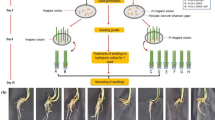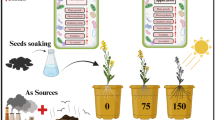Abstract
The secondary compost products (SCP), originated from secondary composting process of the agriculture organic waste fermentation CO2 enrichment devices, can promote tomato plants growth, yield and fruit quality, while reducing the emission of greenhouse gas and organic wastes to the environment, which contributing to the building of carbon neutral and peak. However, the molecular mechanisms and metabolic pathways by which tomato plants responses to SCP treated soil are unknown. In this case, leaf metabolome and transcriptome were compared in the tomato plants grown under SCP, chemical fertilizer (CF) and organic fertilizer (OF). Results showed that SCP application improved primary metabolism especially TCA cycle, carbohydrate metabolism and amino acid metabolism, and also enhanced secondary metabolism especially phenylpropanoid metabolism in tomato leaves when compared with that of CF. Meanwhile, SCP induced significantly down-regulation in ethylene-related genes, while up-regulation in jasmonic acid and gibberellin related genes, which together with the increase of Jasmonate ZIM-domain protein and decrease of DELLA protein endow good balance between growth and environment adaptation ability of plants under SCP treatment. Our findings provide an insight into the molecular and metabolomic response to SCP treated tomato plants for the first time, contributing to the construction of climate-smart agriculture.




Similar content being viewed by others

References
Abbas T, Rizwan M, Ali S, Adrees M, Mahmood A, Zia-Ur-Rehman M, Ibrahim M, Arshad M, Qayyum MF (2018) Biochar application increased the growth and yield and reduced cadmium in drought stressed wheat grown in an aged contaminated soil. Ecotoxicol Environ Saf 148:825–833
Alonso JM, Hirayama T, Roman G, Nourizadeh S, Ecker JR (1999) EIN2, a bifunctional transducer of ethylene and stress responses in Arabidopsis. Science 284(5423):2148–2152
Booker MA, DeLong A (2015) Producing the ethylene signal: regulation and diversification of ethylene biosynthetic enzymes. Plant Physiol 169(1):42–50
Cao GL, Zhang XY, Zheng FC, Wang YQ (2006) Estimating the quantity of crop residues burnt in open field in China. Res Sci 28(1):9–13
Cao Y, Gao Y, Qi Y, Li J (2018) Biochar-enhanced composts reduce the potential leaching of nutrients and heavy metals and suppress plant-parasitic nematodes in excessively fertilized cucumber soils. Environ Sci Pollut Res Int 25:7589–7599
Cheng ZW, Sun L, Qi TC, Zhang B, Peng W, Liu YL, Xie DX (2011) The bHLH transcription factor MYC3 interacts with the jasmonate ZIM-domain proteins to mediate jasmonate response in Arabidopsis. Mol plant 4(2):279–288
Chepyshko H, Lai CP, Huang LM, Liu JH, Shaw JF (2012) Multifunctionality and diversity of GDSL esterase/lipase gene family in rice (Oryza sativa L. japonica) genome: new insights from bioinformatics analysis. BMC Genomics 13(1):309
Chico JM, Chini A, Fonseca S, Solano R (2008) JAZ repressors set the rhythm in jasmonate signaling. Curr Opin Plant Biol 11(5):486–494
Colquhoun TA, Kim JY, Wedde AE, Levin LA, Schmitt KC, Schuurink RC, Clark DG (2011) PhMYB4 fine-tunes the floral volatile signature of Petunia×hybrida through PhC4H. J Exp Bot 62(3):1133–1143
Dubos C, Le Gourrierec J, Baudry A, Huep G, Lanet E, Debeaujon I, Routaboul JM, Alboresi A, Weisshaar B, Lepiniec L (2008) MYBL2 is a new regulator of flavonoid biosynthesis in Arabidopsis thaliana. Plant J 55:940–953
Dugasa MT, Feng X, Wang NH, Wang JM, Wu FB (2021) Comparative transcriptome and tolerance mechanism analysis in the two contrasting wheat (Triticum aestivum L.) cultivars in response to drought and salinity stresses. Plant Growth Regul 94:101–114
Feng TY, Zhang Y, He M, Zhang MC, Li ZH, Zhou YY, Duan LS (2022) Coronatine alleviates cold stress by improving growth and modulating antioxidative defense system in rice (Oryza sativa L.) seedlings. Plant Growth Regul 96:283–291
Figueroa P, Browse J (2012) The Arabidopsis JAZ2 promoter contains a G-Box and thymidine-rich module that are necessary and sufficient for jasmonate-dependent activation by MYC transcription factors and repression by JAZ proteins. Plant Cell Physiol 53(2):330–343
Fujimoto SY, Ohta M, Usui A, Shinshi H, Ohme-Takagi M (2000) Arabidopsis ethylene-responsive element binding factors act as transcriptional activators or repressors of GCC box-mediated gene expression. Plant Cell 12:393–404
Gao D, Chen TB, Liu B, Zheng YM, Zheng GD, Li YX (2006) Releases of pollutants from poultry manure in China and recommended strategies for the pollution prevention. Geogr Res 25(2):311–319
Gao XH, Xiao SL, Yao QF, Wang YJ, Fu XD (2011) An updated GA signaling ‘relief of repression’ regulatory model. Mol Plant 4(4):601–606
Hao PF, Qiu CW, Ding GH, Vincze E, Zhang GP, Zhang YS, Wu FB (2020) Agriculture organic wastes fermentation CO2 enrichment in greenhouse and the fermentation residues can improve growth, yield and fruit quality in tomato. J Clean Prod 275:123885
Heleno SA, Martins A, Queiroz MJR, Ferreira IC (2015) Bioactivity of phenolic acids: metabolites versus parent compounds: a review. Food Chem 173:501–513
Höfer R, Boachon B, Renault H, Gavira C, Miesch L, Iglesias J, Ginglinger JF, Allouche L, Miesch M, Grec S, Larbat R, Reichhart DW (2014) Dual function of the cytochrome P450 CYP76 family from Arabidopsis thaliana in the metabolism of monoterpenols and phenylurea herbicides. Plant Physiol 166(3):1149–1161
Hu T, Zeng H, Hu Z, Qv X, Chen G (2013) Overexpression of the tomato 13-lipoxygenase gene TomloxD increases generation of endogenous jasmonic acid and resistance to Cladosporium fulvum and high temperature. Plant Mol Biol Rep 31(5):1141–1149
Jeong SW, Das PK, Jeoung SC, Song JY, Lee HK, Kim YK, Kim WJ, Park YI, Yoo SD, Choi SB, Choi G, Park YI (2010) Ethylene suppression of sugar-induced anthocyanin pigmentation in Arabidopsis. Plant Physiol 154:1514–1531
Jin CW, Du ST, Wang Y, Condon J, Lin XY, Zhang YS (2009) Carbon dioxide enrichment by composting in greenhouses and its effect on vegetable production. J Plant Nutr Soil Sci 172:418–424
Kanwal S, Ilyas N, Shabir S, Saeed M, Gul R, Zahoor M, Batool N, Mazhar R (2017) Application of biochar in mitigation of negative effects of salinity stress in wheat (Triticum aestivum L). J Plant Nutr 41:526–538
Kazan K (2015) Diverse roles of jasmonates and ethylene in abiotic stress tolerance. Trends Plant Sci 20(4):219–229
Lee J, Han CT, Hur Y (2013) Molecular characterization of the Brassica rapa auxin-repressed, superfamily genes, BrARP1 and BrDRM1. Mol Biol Rep 40:197–209
Lehmann J, Rillig MC, Thies J, Masiello CA, Hockaday WC, Crowley D (2011) Biochar effects on soil biota-A review. Soil Biol Biochem 43:1812–1836
Liu CH, Zheng HH, Sheng KL, Liu W, Zheng L (2018) Effects of postharvest UV-C irradiation on phenolic acids, flavonoids, and key phenylpropanoid pathway genes in tomato fruit. Sci Horticulturae 241:107–114
Liu LJ, Sun CL, He XL, Liu XX, Wu H, Liu M, Tang CX, Zhang YS (2016) The secondary compost products enhances soil suppressive capacity against bacterial wilt of tomato caused by Ralstonia solanacearum. Eur J Soil Biol 75:70–78
Matros A, Amme S, Kettig B, Buck-Sorlin GH, Sonnewald UWE, Mock HP (2006) Growth at elevated CO2 concentrations leads to modified profiles of secondary metabolites in tobacco cv. SamsunNN and to increased resistance against infection with potato virus Y. Plant Cell Environ 29(1):126–137
Ohbayashi I, Huang S, Fukaki H, Song X, Sun S, Morita MT, Tasaka M, Millar AH, Furutani M (2019) Mitochondrial pyruvate dehydrogenase contributes to Auxin-regulated organ development. Plant Physiol 180(2):896–909
Peng JY, Li ZH, Wen X, Li WY, Shi H, Yang LS, Zhu HQ, Guo HW (2014) Salt-induced stabilization of EIN3/EIL1 confers salinity tolerance by deterring ROS accumulation in Arabidopsis.PLoS Genet10(10)
Sharma N, Chaudhary C, Khurana P (2022) Transcriptome profiling of somatic embryogenesis in wheat (Triticum aestivum L.) influenced by auxin, calcium and brassinosteroid. Plant Growth Regul 98:599–612
Schmidt CL, Danneel HJ, Schultz G, Buchanan BB (1990) Shikimate kinase from spinach chloroplasts: purification, characterization, and regulatory function in aromatic amino acid biosynthesis. Plant Physiol 93(2):758–766
Tamiru M, Undan JR, Takagi H, Abe A, Yoshida K, Undan JQ, Natsume S, Uemura A, Saitoh H, Matsumura H, Urasaki N, Yokota T, Terauchi R (2015) A cytochrome P450, OsDSS1, is involved in growth and drought stress responses in rice (Oryza sativa L). Plant Mol Biol 88(1–2):85–99
Thomas SC, Frye S, Gale N, Garmon M, Launchbury R, Machado N, Melamed S, Murray J, Petroff A, Winsborough C (2013) Biochar mitigates negative effects of salt additions on two herbaceous plant species. J Environ Manage 129:62–68
Wang KLC, Li H, Ecker JR (2002) Ethylene biosynthesis and signaling networks. Plant Cell 14:S131–S151
Xu Q, Yin XR, Zeng JK, Ge H, Song M, Xu CJ, Li X, Ferguson LB, Chen KS (2014) Activator-and repressor-type MYB transcription factors are involved in chilling injury induced flesh lignification in loquat via their interactions with the phenylpropanoid pathway. J Exp Bot 65(15):4349–4359
Yue JY, Du CJ, Ji J, Xie TT, Chen W, Chang E, Chen LZ, Jiang ZP (2018) Inhibition of α-ketoglutarate dehydrogenase activity affects adventitious root growth in poplar via changes in GABA shunt. Planta 248(4):963–979
Zhang J, Zhuang MH, Shan N, Zhao Q, Li H, Wang LG (2019) Substituting organic manure for compound fertilizer increases yield and decreases NH3 and N2O emissions in an intensive vegetable production systems. Sci Total Environ 670:1184–1189
Zhang X, Zhu ZQ, An FY, Hao DD, Li PP, Song JH, Yi CQ, Guo HW (2014) Jasmonate-activated MYC2 represses ETHYLENE INSENSITIVE3 activity to antagonize ethylene-promoted apical hook formation in Arabidopsis. Plant Cell 26(3):1105–1117
Zhang XB, Gou MY, Guo CR, Yang HJ, Liu CJ (2015) Down-regulation of Kelch domain-containing F-box protein in Arabidopsis enhances the production of (poly) phenols and tolerance to ultraviolet radiation. Plant Physiol 167(2):337–350
Zhang XB, Gou MY, Liu CJ (2013) Arabidopsis Kelch repeat F-box proteins regulate phenylpropanoid biosynthesis via controlling the turnover of phenylalanine ammonia-lyase. Plant Cell 25(12):4994–5010
Zhang YJ, Fernie AR (2018) On the role of the tricarboxylic acid cycle in plant productivity. J Integr Plant Biol 60(12):1199–1216
Zvomuya F, Helgason BL, Larney FJ, Janzen HH, Akinremi OO, Olson BM (2006) Predicting phosphorus availability from soil-applied composted and non-composted cattle feedlot manure. J Environ Qual 35:928–937
Funding
This research was supported by National Key Technology Research and Development Program of the Ministry of Science and Technology of China (2015BAC02B03).
Author information
Authors and Affiliations
Contributions
FBW planned and designed the research. PFH, CWQ, YW and WL performed experiments. PFH, FBW and SH analyzed data. PFH wrote the manuscript. FBW Supplied resources, reviewed and validated the manuscript. FBW, SH, EV, and PFH revised the manuscript with contribution from all authors.
Corresponding author
Ethics declarations
Conflict of interest
The authors declare no conflict of interest.
Additional information
Communicated by Dali Zeng.
Publisher’s Note
Springer Nature remains neutral with regard to jurisdictional claims in published maps and institutional affiliations.
Electronic supplementary material
Below is the link to the electronic supplementary material.
Table S1 Dose of base fertilizer application in each treatment.
Table S2 Primers sequences used in this study.
Table S3 Differential expressed primary metabolites of tomato leaves under SCP and OF compared with CF.
Table S4 Co-differentially expressed genes of tomato leaves in SCP and OF compared with CF.
Fig. S1 Principal component analysis (PCA) of metabolites (A) and transcripts (B) in tomato leaves.
Fig. S2 Pathway classification of KEGG enrichment analysis of differentially expressed genes (DEGs).
Fig. S3 Changes in metabolites mapped to TCA cycle.
Fig. S4 Overview of the metabolites mapped to each secondary metabolism pathway.
Rights and permissions
Springer Nature or its licensor (e.g. a society or other partner) holds exclusive rights to this article under a publishing agreement with the author(s) or other rightsholder(s); author self-archiving of the accepted manuscript version of this article is solely governed by the terms of such publishing agreement and applicable law.
About this article
Cite this article
Hao, P., Qiu, C., Wu, Y. et al. Secondary compost products improved tomato production via regulating primary/secondary metabolism and hormone signal interaction. Plant Growth Regul 102, 167–178 (2024). https://doi.org/10.1007/s10725-023-00990-6
Received:
Accepted:
Published:
Issue Date:
DOI: https://doi.org/10.1007/s10725-023-00990-6



